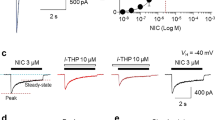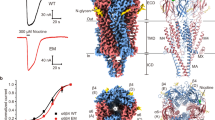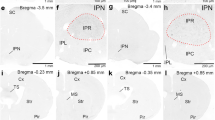Abstract
Genomic and pharmacologic data have suggested the involvement of the α3β4 subtype of nicotinic acetylcholine receptors (nAChRs) in drug seeking to nicotine and other drugs of abuse. In order to better examine this receptor subtype, we have identified and characterized the first high affinity and selective α3β4 nAChR antagonist, AT-1001, both in vitro and in vivo. This is the first reported compound with a Ki below 10 nM at α3β4 nAChR and >90-fold selectivity over the other major subtypes, the α4β2 and α7 nAChR. AT-1001 competes with epibatidine, allowing for [3H]epibatidine binding to be used for structure-activity studies, however, both receptor binding and ligand-induced Ca2+ flux are not strictly competitive because increasing ligand concentration produces an apparent decrease in receptor number and maximal Ca2+ fluorescence. AT-1001 also potently and reversibly blocks epibatidine-induced inward currents in HEK cells transfected with α3β4 nAChR. Importantly, AT-1001 potently and dose-dependently blocks nicotine self-administration in rats, without affecting food responding. When tested in a nucleus accumbens (NAcs) synaptosomal preparation, AT-1001 inhibits nicotine-induced [3H]dopamine release poorly and at significantly higher concentrations compared with mecamylamine and conotoxin MII. These results suggest that its inhibition of nicotine self-administration in rats is not directly due to a decrease in dopamine release from the NAc, and most likely involves an indirect pathway requiring α3β4 nAChR. In conclusion, our studies provide further evidence for the involvement of α3β4 nAChR in nicotine self-administration. These findings suggest the utility of this receptor as a target for smoking cessation medications, and highlight the potential of AT-1001 and congeners as clinically useful compounds.
Similar content being viewed by others
Log in or create a free account to read this content
Gain free access to this article, as well as selected content from this journal and more on nature.com
or
References
Arias HR, Rosenberg A, Feuerbach D, Targowska-Duda KM, Maciejewski R, Jozwiak K et al. (2010). Interaction of 18-methoxycoronaridine with nicotinic acetylcholine receptors in different conformational states. Biochim Biophys Acta 1798: 1153–1163.
Belluzzi JD, Wang R, Leslie FM (2005). Acetaldehyde enhances acquisition of nicotine self-administration in adolescent rats. Neuropsychopharmacology 30: 705–712.
Berrettini W, Yuan X, Tozzi F, Song K, Francks C, Chilcoat H et al. (2008). Alpha-5/alpha-3 nicotinic receptor subunit alleles increase risk for heavy smoking. Mol Psychiatry 13: 368–373.
Bierut LJ, Stitzel JA, Wang JC, Hinrichs AL, Grucza RA, Xuei X et al. (2008). Variants in nicotinic receptors and risk for nicotine dependence. Am J Psychiatry 165: 1163–1171.
Cao J, Belluzzi JD, Loughlin SE, Keyler DE, Pentel PR, Leslie FM (2007). Acetaldehyde, a major constituent of tobacco smoke, enhances behavioral, endocrine, and neuronal responses to nicotine in adolescent and adult rats. Neuropsychopharmacology 32: 2025–2035.
Caporaso N, Gu F, Chatterjee N, Sheng-Chih J, Yu K, Yeager M et al. (2009). Genome-wide and candidate gene association study of cigarette smoking behaviors. PLoS One 4: e4653.
Chavez-Noriega LE, Crona JH, Washburn MS, Urrutia A, Elliott KJ, Johnson EC (1997). Pharmacological characterization of recombinant human neuronal nicotinic acetylcholine receptors h alpha 2 beta 2, h alpha 2 beta 4, h alpha 3 beta 2, h alpha 3 beta 4, h alpha 4 beta 2, h alpha 4 beta 4 and h alpha 7 expressed in Xenopus oocytes. J Pharmacol Exp Ther 280: 346–356.
Cheng Y, Prusoff WH (1973). Relationship between the inhibition constant (K1) and the concentration of inhibitor which causes 50 per cent inhibition (I50) of an enzymatic reaction. Biochem Pharmacol 22: 3099–3108.
Corrigall WA, Coen KM (1989). Nicotine maintains robust self-administration in rats on a limited-access schedule. Psychopharmacology (Berl) 99: 473–478.
Dwoskin LP, Wooters TE, Sumithran SP, Siripurapu KB, Joyce BM, Lockman PR et al. (2008). N,N’-alkane-diyl-bis-3-picoliniums as nicotinic receptor antagonists: inhibition of nicotine-evoked dopamine release and hyperactivity. J Pharmacol Exp Ther 326: 563–576.
Epping-Jordan MP, Picciotto MR, Changeux JP, Pich EM (1999). Assessment of nicotinic acetylcholine receptor subunit contributions to nicotine self-administration in mutant mice. Psychopharmacology (Berl) 147: 25–26.
Fowler CD, Lu Q, Johnson PM, Marks MJ, Kenny PJ (2011). Habenular alpha5 nicotinic receptor subunit signalling controls nicotine intake. Nature 471: 597–601.
Francis MM, Cheng EY, Weiland GA, Oswald RE (2001). Specific activation of the alpha 7 nicotinic acetylcholine receptor by a quaternary analog of cocaine. Mol Pharmacol 60: 71–79.
Glick SD, Maisonneuve IM, Dickinson HA (2000a). 18-MC reduces methamphetamine and nicotine self-administration in rats. Neuroreport 11: 2013–2015.
Glick SD, Maisonneuve IM, Szumlinski KK (2000b). 18-Methoxycoronaridine (18-MC) and ibogaine: comparison of antiaddictive efficacy, toxicity, and mechanisms of action. Ann NY Acad Sci 914: 369–386.
Glick SD, Ramirez RL, Livi JM, Maisonneuve IM (2006). 18-Methoxycoronaridine acts in the medial habenula and/or interpeduncular nucleus to decrease morphine self-administration in rats. Eur J Pharmacol 537 (1–3): 94–98.
Glick SD, Sell EM, McCallum SE, Maisonneuve IM (2011). Brain regions mediating alpha3beta4 nicotinic antagonist effects of 18-MC on nicotine self-administration. Eur J Pharmacol 599: 91–95.
Gotti C, Fornasari D, Clementi F (1997). Human neuronal nicotinic receptors. Prog Neurobiol 53: 199–237.
Gotti C, Guiducci S, Tedesco V, Corbioli S, Zanetti L, Moretti M et al. (2010). Nicotinic acetylcholine receptors in the mesolimbic pathway: primary role of ventral tegmental area alpha6beta2* receptors in mediating systemic nicotine effects on dopamine release, locomotion, and reinforcement. J Neurosci 30: 5311–5325.
Grady SR, Moretti M, Zoli M, Marks MJ, Zanardi A, Pucci L et al. (2009). Rodent habenulo-interpeduncular pathway expresses a large variety of uncommon nAChR subtypes, but only the alpha3beta4* and alpha3beta3beta4* subtypes mediate acetylcholine release. J Neurosci 29: 2272–2282.
Grady SR, Murphy KL, Cao J, Marks MJ, McIntosh JM, Collins AC (2002). Characterization of nicotinic agonist-induced [(3)H]dopamine release from synaptosomes prepared from four mouse brain regions. J Pharmacol Exp Ther 301: 651–660.
Jackson KJ, Marks MJ, Vann RE, Chen X, Gamage TF, Warner JA et al. (2010). Role of alpha5 nicotinic acetylcholine receptors in pharmacological and behavioral effects of nicotine in mice. J Pharmacol Exp Ther 334: 137–146.
Jackson KJ, McIntosh JM, Brunzell DH, Sanjakdar SS, Damaj MI (2009). The role of alpha6-containing nicotinic acetylcholine receptors in nicotine reward and withdrawal. J Pharmacol Exp Ther 331: 547–554.
Klink R, de Kerchove d’Exaerde A, Zoli M, Changeux JP (2001). Molecular and physiological diversity of nicotinic acetylcholine receptors in the midbrain dopaminergic nuclei. J Neurosci 21: 1452–1463.
Maisonneuve IM, Glick SD (2003). Anti-addictive actions of an iboga alkaloid congener: a novel mechanism for a novel treatment. Pharmacol Biochem Behav 75: 607–618.
Mandelzys A, Pie B, Deneris ES, Cooper E (1994). The developmental increase in ACh current densities on rat sympathetic neurons correlates with changes in nicotinic ACh receptor alpha-subunit gene expression and occurs independent of innervation. J Neurosci 14: 2357–2364.
Maskos U, Molles BE, Pons S, Besson M, Guiard BP, Guilloux JP et al. (2005). Nicotine reinforcement and cognition restored by targeted expression of nicotinic receptors. Nature 436: 103–107.
McCallum SE, Glick SD (2009). 18-Methoxycoronaridine blocks acquisition but enhances reinstatement of a cocaine place preference. Neurosci Lett 458: 57–59.
McGehee DS, Heath MJ, Gelber S, Devay P, Role LW (1995a). Nicotine enhancement of fast excitatory synaptic transmission in CNS by presynaptic receptors. Science 269: 1692–1696.
McGehee DS, Role LW (1995b). Physiological diversity of nicotinic acetylcholine receptors expressed by vertebrate neurons. Annu Rev Physiol 57: 521–546.
McIntosh JM, Azam L, Staheli S, Dowell C, Lindstrom JM, Kuryatov A et al. (2004). Analogs of alpha-conotoxin MII are selective for alpha6-containing nicotinic acetylcholine receptors. Mol Pharmacol 65: 944–952.
Perry DC, Mao D, Gold AB, McIntosh JM, Pezzullo JC, Kellar KJ (2007). Chronic nicotine differentially regulates alpha6- and beta3-containing nicotinic cholinergic receptors in rat brain. J Pharmacol Exp Ther 322: 306–315.
Perry DC, Xiao Y, Nguyen HN, Musachio JL, Davila-Garcia MI, Kellar KJ (2002). Measuring nicotinic receptors with characteristics of alpha4beta2, alpha3beta2 and alpha3beta4 subtypes in rat tissues by autoradiography. J Neurochem 82: 468–481.
Picciotto MR (1998). Common aspects of the action of nicotine and other drugs of abuse. Drug Alcohol Depend 51: 165–172.
Picciotto MR, Zoli M, Rimondini R, Lena C, Marubio LM, Pich EM et al. (1998). Acetylcholine receptors containing the beta2 subunit are involved in the reinforcing properties of nicotine. Nature 391: 173–177.
Pons S, Fattore L, Cossu G, Tolu S, Porcu E, McIntosh JM et al. (2008). Crucial role of alpha4 and alpha6 nicotinic acetylcholine receptor subunits from ventral tegmental area in systemic nicotine self-administration. J Neurosci 28: 12318–12327.
Poth K, Nutter TJ, Cuevas J, Parker MJ, Adams DJ, Luetje CW (1997). Heterogeneity of nicotinic receptor class and subunit mRNA expression among individual parasympathetic neurons from rat intracardiac ganglia. J Neurosci 17: 586–596.
Quick MW, Ceballos RM, Kasten M, McIntosh JM, Lester RA (1999). Alpha3beta4 subunit-containing nicotinic receptors dominate function in rat medial habenula neurons. Neuropharmacology 38: 769–783.
Quik M, Sum JD, Whiteaker P, McCallum SE, Marks MJ, Musachio J et al. (2003). Differential declines in striatal nicotinic receptor subtype function after nigrostriatal damage in mice. Mol Pharmacol 63: 1169–1179.
Rezvani AH, Overstreet DH, Yang Y, Maisonneuve IM, Bandarage UK, Kuehne ME et al. (1997). Attenuation of alcohol consumption by a novel nontoxic ibogaine analogue (18-methoxycoronaridine) in alcohol-preferring rats. Pharmacol Biochem Behav 58: 615–619.
Rollema H, Chambers LK, Coe JW, Glowa J, Hurst RS, Lebel LA et al. (2007). Pharmacological profile of the alpha4beta2 nicotinic acetylcholine receptor partial agonist varenicline, an effective smoking cessation aid. Neuropharmacology 52: 985–994.
Saccone SF, Saccone NL, Swan GE, Madden PA, Goate AM, Rice JP et al. (2008). Systematic biological prioritization after a genome-wide association study: an application to nicotine dependence. Bioinformatics 24: 1805–1811.
Salas R, Pieri F, De Biasi M (2004). Decreased signs of nicotine withdrawal in mice null for the beta4 nicotinic acetylcholine receptor subunit. J Neurosci 24: 10035–10039.
Stolerman IP, Shoaib M (1991). The neurobiology of tobacco addiction. Trends Pharmacol Sci 12: 467–473.
Tapper AR, McKinney SL, Nashmi R, Schwarz J, Deshpande P, Labarca C et al. (2004). Nicotine activation of alpha4* receptors: sufficient for reward, tolerance, and sensitization. Science 306: 1029–1032.
Thorgeirsson TE, Geller F, Sulem P, Rafnar T, Wiste A, Magnusson KP et al. (2008). A variant associated with nicotine dependence, lung cancer and peripheral arterial disease. Nature 452: 638–642.
Watkins SS, Epping-Jordan MP, Koob GF, Markou A (1999). Blockade of nicotine self-administration with nicotinic antagonists in rats. Pharmacol Biochem Behav 62: 743–751.
Wooters TE, Smith AM, Pivavarchyk M, Siripurapu KB, McIntosh JM, Zhang Z et al. (2011). bPiDI: a novel selective alpha6beta2* nicotinic receptor antagonist and preclinical candidate treatment for nicotine abuse. Br J Pharmacol 163: 346–357.
Xiao Y, Kellar KJ (2004). The comparative pharmacology and up-regulation of rat neuronal nicotinic receptor subtype binding sites stably expressed in transfected mammalian cells. J Pharmacol Exp Ther 310: 98–107.
Zaveri N, Jiang F, Olsen C, Polgar W, Toll L (2010). Novel alpha3beta4 nicotinic acetylcholine receptor-selective ligands. Discovery, structure-activity studies, and pharmacological evaluation. J Med Chem 53: 8187–8191.
Acknowledgements
Determination of binding affinity of AT-1001 at a panel of various receptors and ion channels was generously provided by the National Institute of Mental Health's Psychoactive Drug Screening Program, Contract # HHSN-271-2008-00025-C (NIMH PDSP). The NIMH PDSP is directed by Bryan L Roth MD, PhD at the University of North Carolina at Chapel Hill and Project Officer Jamie Driscol at NIMH, Bethesda MD, USA. This research was supported by grants from the National Institute on Drug Abuse DA020811 (LT) and the UC Tobacco Related Diseases Research Program 18XT-0085 (FL).
Author information
Authors and Affiliations
Corresponding authors
Ethics declarations
Competing interests
The authors declare no conflict of interest.
Additional information
Preliminary reports of these data were presented at the annual meetings of the Society for Neuroscience.
Supplementary Information accompanies the paper on the Neuropsychopharmacology website
Rights and permissions
About this article
Cite this article
Toll, L., Zaveri, N., Polgar, W. et al. AT-1001: A High Affinity and Selective α3β4 Nicotinic Acetylcholine Receptor Antagonist Blocks Nicotine Self-Administration in Rats. Neuropsychopharmacol 37, 1367–1376 (2012). https://doi.org/10.1038/npp.2011.322
Received:
Revised:
Accepted:
Published:
Issue date:
DOI: https://doi.org/10.1038/npp.2011.322
Keywords
This article is cited by
-
Elucidating the reinforcing effects of nicotine: a tribute to Nadia Chaudhri
Psychopharmacology (2023)
-
Tobacco smoke exposure enhances reward sensitivity in male and female rats
Psychopharmacology (2021)
-
Structural mechanisms for α-conotoxin activity at the human α3β4 nicotinic acetylcholine receptor
Scientific Reports (2017)
-
Pharmacotherapy: Quest for the quitting pill
Nature (2015)
-
Differentiating the primary reinforcing and reinforcement-enhancing effects of varenicline
Psychopharmacology (2015)



